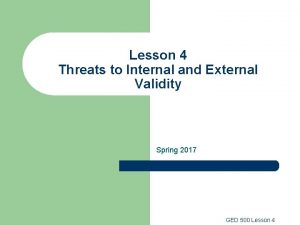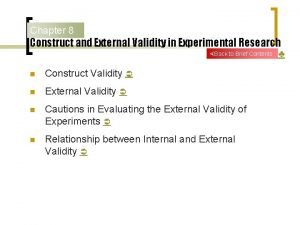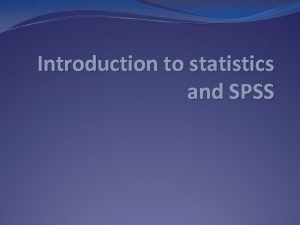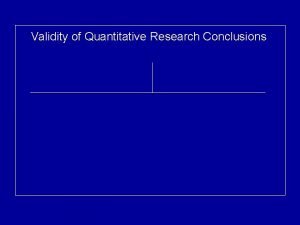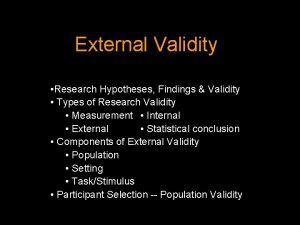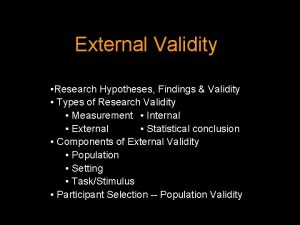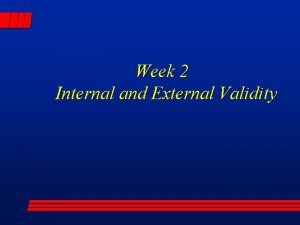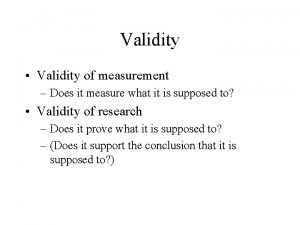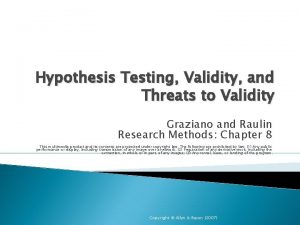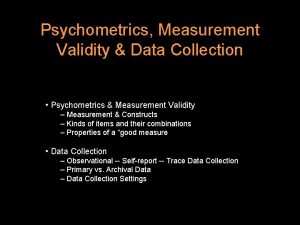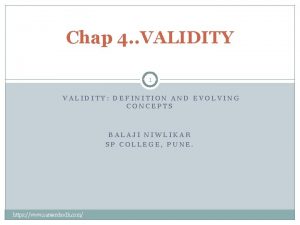External Validity How Do We Generalize specified persons






















- Slides: 22

External Validity

How Do We Generalize? specified persons, places , times Population

How Do We Generalize? Population draw sample Sample draw sample

How Do We Generalize? generalize back Population Sample

Threats to External Validity Interaction of Selection and Treatment Interaction of Setting and Treatment Interaction of History and Treatment maybe it is just these people maybe it is just these places and conditions maybe it is just these times

How Can We Improve External Validity?

How Can We Improve External Validity? Population random sampling Sample

How Can We Improve External Validity? Population random sampling Our Study tim es replicate, replicate places Sample people

How Can We Improve External Validity? Population random sampling Our Study tim es replicate, replicate places Sample people settings use theory times Our Study places people

Internal validity

Validity • Validity: The best available approximation to the truth of a given proposition, inference or conclusion. n The first question we have to ask is “validity of what? ”

Sampling Measurement Design Analysis

Internal validity • Internal validity is the approximate truth about inferences regarding cause effect or causal relationships. • Internal validity is only relevant in studies that try to establish a causal relationship. It is not relevant in most observational or descriptive studies. • For studies that assess the effects of educational program or interventions, internal validity is perhaps the primary consideration.

Internal validity The key question in internal validity is whether observed changes can be attributed to your program or intervention (i. e. cause) and not to other possible causes (alternative explanations)

Threats to Internal validity • We divide threats to validity into three categories: – Single group threats – Multiple group threats – Social interaction threats

Single group threats

Single group threats • When you observe a change or gain of outcome from pretest to posttest after implementation of a program, you want to conclude that the outcome is due to your program. How could you be wrong? – – – History threat Maturation threat Testing threat Instrumentation threat Mortality threat Regression threat

History threat • It’s not your program that caused the outcome, it’s something else, some historical event that occurred.

Maturation threat • Some outcomes change with time (natural history) even if they had never confronted with your program. All you are doing is measuring normal maturation or growth over time.

Difference between maturation and history threats • If we’re talking about a specific event or chain of events that could cause the outcome, we call it a history threat. • If we’re talking about all of the events that typically transpire in your life over a period of time (without being specific as to which ones are the active causal agents) we call it a maturation threat.

Mortality threat • In mortality threat people in your study are dropping out of the study. This may change the composition of pretest and posttest groups, making comparison of them invalid.

 One person's garbage is another person's treasure
One person's garbage is another person's treasure Criterion validity vs predictive validity
Criterion validity vs predictive validity Generalization of the paragraph
Generalization of the paragraph Data warehouses generalize and consolidate data in space.
Data warehouses generalize and consolidate data in space. Lenfadenopati
Lenfadenopati Internal validity
Internal validity Mono-operation bias
Mono-operation bias Winsorizing spss
Winsorizing spss Reactive effects of experimental arrangements
Reactive effects of experimental arrangements External validity definition
External validity definition External validity definition
External validity definition Segmentation and paging
Segmentation and paging In an incompletely specified machine
In an incompletely specified machine Remix invalid input source specified
Remix invalid input source specified Dissociative disorder not otherwise specified
Dissociative disorder not otherwise specified Specified risk materials
Specified risk materials Dissociative disorder not otherwise specified
Dissociative disorder not otherwise specified Design of satellite link for specified c/n
Design of satellite link for specified c/n Dissociative fugue
Dissociative fugue Write the specified type of proof
Write the specified type of proof Specified accommodation
Specified accommodation Dissociative disorder not otherwise specified
Dissociative disorder not otherwise specified Microprocessor are
Microprocessor are





